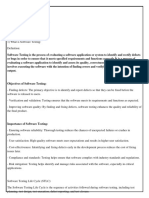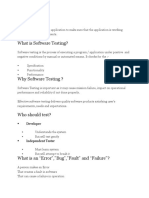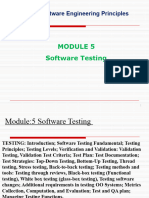Research Document: Software Testing
Abstract
Software testing is the process of evaluating and verifying that a software product functions as
intended. It is essential for ensuring quality, reliability, and user satisfaction. This paper provides
a brief overview of software testing concepts, methods, and importance.
1. Introduction
Modern software systems are complex and often mission-critical. Defects can lead to financial
loss, reputational damage, or even safety risks. Testing identifies errors, ensures requirements
are met, and improves confidence in software performance.
2. Types of Software Testing
2.1 By Objective
● Functional Testing: Verifies what the system does (e.g., login, data processing).
● Non-Functional Testing: Verifies how the system works (e.g., performance, security,
usability).
2.2 By Approach
● Static Testing: Examines code or documents without execution (reviews, inspections).
● Dynamic Testing: Executes the software to check behavior (unit, integration, system
tests).
2.3 Common Levels
● Unit Testing: Validates individual components.
● Integration Testing: Ensures modules interact correctly.
● System Testing: Evaluates the complete system.
● Acceptance Testing: Confirms readiness for end-users or clients.
3. Testing Methods
� ● Manual Testing: Human testers execute test cases.
● Automated Testing: Tools/scripts run repetitive tests efficiently.
● Black-Box Testing: Focuses on inputs/outputs, not internal code.
● White-Box Testing: Examines internal logic and structure.
4. Importance of Software Testing
● Ensures quality and reliability.
● Detects defects early, reducing cost of fixes.
● Improves security and user confidence.
● Supports compliance with industry standards.
5. Conclusion
Software testing is a critical stage in the software development life cycle (SDLC). By applying
systematic methods—functional, non-functional, manual, and automated—developers and
testers ensure that products are robust, efficient, and aligned with user expectations. Effective
testing ultimately safeguards organizations from risks while delivering value to end-users.
References
● Myers, Glenford J. The Art of Software Testing. Wiley, 3rd Edition.
● ISTQB Foundation Syllabus, International Software Testing Qualifications Board.
























































